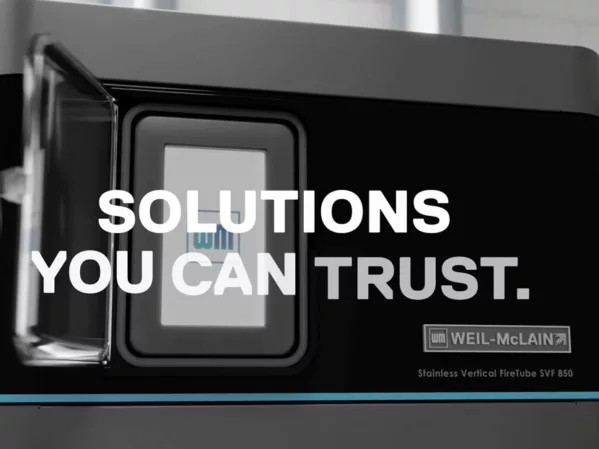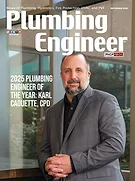Special to Plumbing Engineer from ThermOmegaTech
ThermOmegaTech has a solution. By installing Circuit Solver at the end of each hot water supply branch before it connects back into the return, you are assured of having the right water temperature at all times. This allows for the right temperature of hot water to be made available at any hot water fixture in a building, regardless of the time of day.
For more than 30 years, ThermOmegaTech has been building freeze protection valves for Class 1 locomotives. Presently, the company has over 98 percent market share for Class 1 locomotives in North America. All of ThermOmegaTech’s products, including Circuit Solver, use the same technology that was developed for the railroad industry. The company has branched out with numerous products supporting a number of industries.
Plumbing Engineer learned more about Circuit Solver, and some of the questions that ThermOmegaTech frequently hears about the offering.
Plumbing Engineer: What was the genesis of Circuit Solver and its design?
ThermOmegaTech: It’s not an unusual source for new ideas, but a customer came to us with a problem because they saw we make the types of valves or devices that might help his application. ThermOmegaTech was already manufacturing an inline, self-operating, thermostatic valve that closes on temperature rise, so we showed the customer this valve. The customer (in this case a commercial plumbing systems expert) asked if this valve could be made to open at 110°F and close at 120°F, for example. We already had such a valve, but the discussion progressed further and with some development work the valve was simplified, made more compact, optimized for recirculating domestic hot water systems; and thus was born Circuit Solver.
The primary reason the plumbing systems expert came to us (and during development this was supported by feedback from many others in that industry) is because manual balancing of recirculating domestic hot water systems is very problematic and inefficient. Logically, if you are trying to control flow based on the temperature of the water at the end of a supply branch, why not use a valve that is “smart” enough to know what that water temperature is, and regulate flow accordingly? That is what Circuit Solver does. Circuit Solver is an innovative manual balancing valve, and eliminates all the time-consuming procedures and headaches associated with trying to manually balance a recirculating DHW system.
Plumbing Engineer: What applications are best suited to Circuit Solver?
ThermOmegaTech: Any building that has a recirculating domestic hot water system will benefit by using Circuit Solver – hotels, hospitals, dormitories, and high-rise apartments/condominiums are all institutions where we have had a lot of success with Circuit Solver.
Plumbing Engineer: How does a designer size their pump and select Circuit Solver?
ThermOmegaTech: The recirculation pump has to be sized to flow enough hot water to offset the heat loss in all the supply branches. Using manual balancing valves, plumbing system designers commonly add safety factors to this flow number because it is very difficult, nearly impossible, to balance a multi-branch system with the theoretically correct flow rate. This leads to grossly oversized recirculation pumps and associated problems with flow induced erosion and increased operating and maintenance costs. By using Circuit Solver, the recirculation pump can be sized exactly to the flow required to offset the heat loss. Simply choose a Circuit Solver of the same pipe size as the end of the supply branch and specify the desired water temperature at the end of each supply branch.
Plumbing Engineer: Can it be used with a VFD driven pump?
ThermOmegaTech: Yes, Circuit Solver offers unique advantages when combined with VFD pumps, especially the more recent smart VFD recirculation pumps that have built-in temperature and pressure sensors and controls. As Circuit Solvers modulate the return water flow rate based on water temperature, the smart VFD pumps are able to reduce pump RPMs (lower electrical consumption) when appropriate to further enhance the overall system efficiency.
Plumbing Engineer: What is the pressure drop at a given flow rate?
ThermOmegaTech: For Circuit Solver, we publish the pressure drop for the “full open” valve as well as the “closed” valve. In general, there is usually a 10°F range between full open and closed; e.g., full open 110°F and closed 120°F. Circuit Solvers are designed to have a small amount of bypass leakage even when “closed” to help sense changing upstream water temperatures more quickly and to eliminate concerns about “dead heading” the recirculation pump. We also publish a flow chart showing flow and pressure drop at partially open positions that relate to water temperatures between full open and closed. Using any of the published “Cv” flow coefficients, pressure drop and flow rate are related by:
GPM = Cv X (square root of pressure drop in psi)
Plumbing Engineer: What is the warranty? Can it be repaired in the field?
ThermOmegaTech: Circuit Solver has a 3-year warranty. We have found it to be highly resistive to scaling. Circuit Solver is an all stainless steel, heavy duty thermostatic valve that is highly resistant to corrosion and normal wear and tear. Circuit Solver can be field rebuilt if that is economically feasible compared to replacement. The only active component inside Circuit Solver is the thermal actuator, which is replaceable.
Plumbing Engineer: Does a dielectric union/coupling need to be used with Circuit Solver?
ThermOmegaTech: A dielectric union/coupling does not have to be used with Circuit Solver. We have not seen or heard of any case where dissimilar metals between Circuit Solver and copper or brass piping, tubing, or other valves has caused galvanic corrosion. According to technical reports published by the copper, brass, and stainless steel industries, this corrosion problem would be of concern in stagnated or very low flow plumbing systems. DHW recirculation systems are not stagnated or in a low flow status long enough to allow this problem to occur.
Plumbing Engineer: Is there a standard position of Circuit Solver when no fixtures are open in a given branch?
ThermOmegaTech: Each recirculation branch has its own flow versus water temperature curve, based on pipe length, pipe diameter, insulation, ambient temperature, etc. In other words, the higher the water flow rate in a branch the higher the water temperature. Circuit Solvers are proportioning valves: the higher the water temperature the lower the flow (valve position). The steady state position of Circuit Solver (no fixtures on) is at the point where the braches temperature vs flow curve and Circuit Solver’s temperature versus flow curve intersect with each other. This is typically between 75 and 90 percent closed. A Circuit Solver is only at a fully closed bypass leakage position when a fixture in the branch is “on,” drawing additional hot water to the branch.
Plumbing Engineer: What approvals/certifications does Circuit Solver have?
ThermOmegaTech: Circuit Solver is stainless steel, no lead. Is has NSF/ANSI 61 and AB1953 Certifications. It also has Massachusetts Board approval.
Plumbing Engineer: How well does Circuit Solver hold up to high mineral content water?
ThermOmegaTech: Circuit Solver is all stainless steel, is a proportioning valve that moves against a spring, to control flow to overcome heat loss, so it is highly resistant to scaling buildup and small particles that may be in the line. We have removed valves that have been in high mineral content water for a few years; they have not exhibited any perceptible scaling buildup.
Many buildings require multiple branches off the hot water supply line. Water flows to the path of least resistance. Hot water use is hyper-dynamic, so the path of least resistance constantly changes. Because flow rates often have to be set much higher than “optimum,” manual balancing valves or constant flow balancing valves cannot effectively resolve these issues.



